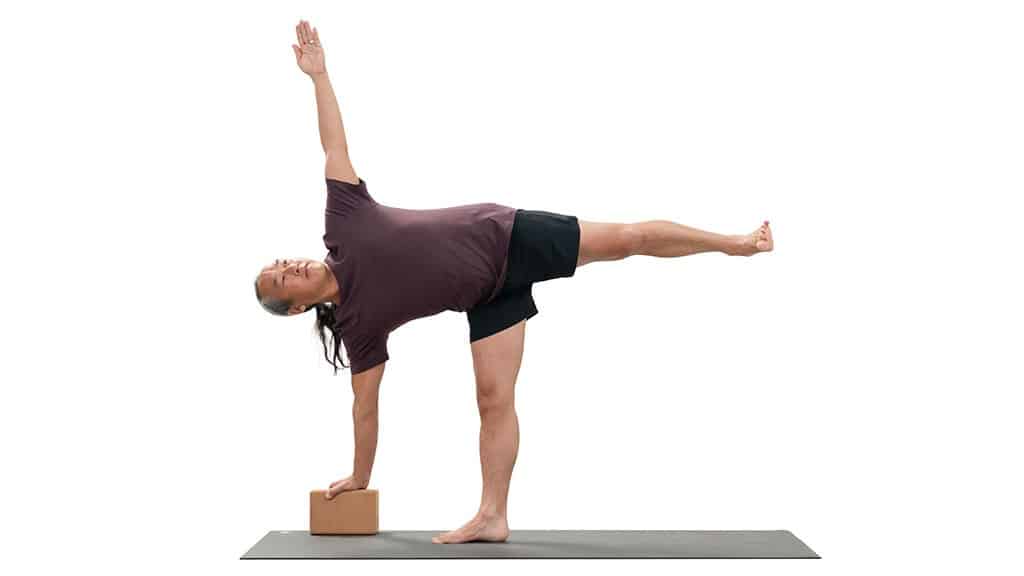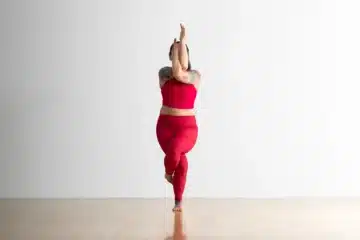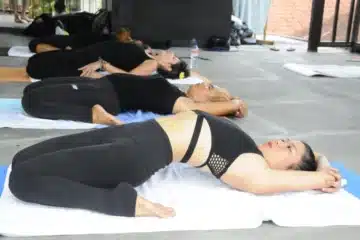In the realm of yoga, each asana holds within it a story of strength, flexibility, and inner harmony. Among these myriad postures, Half Moon Pose, or Ardha Chandrasana, stands out as a dynamic and graceful expression of balance and poise.
Rooted in the ancient wisdom of yoga, this pose invites practitioners to tap into their inner stability, cultivate focus, and awaken a sense of lightness and freedom.
Let’s embark on a journey into the essence of Half Moon Pose and uncover its transformative benefits:
Benefits of Ardha Chandrasana:
- Enhances Balance: Half Moon Pose challenges practitioners to find balance on one leg while extending the body laterally. By honing proprioception and stability, this posture strengthens the muscles of the legs, ankles, and core, improving overall balance and coordination.
- Opens the Hips and Groin: Ardha Chandrasana offers a deep stretch to the hips, groins, and hamstrings. As the body extends sideways, the hip flexors and abductors are gently stretched, releasing tension and promoting flexibility in the pelvic region.
- Strengthens the Entire Body: Holding Half Moon Pose requires engagement and activation of multiple muscle groups, including the legs, glutes, abdomen, and back. This strengthens the entire body, tones the muscles, and improves posture and alignment.
- Expands the Chest and Shoulders: As the torso opens towards the sky, Half Moon Pose stretches the chest and shoulders, counteracting the effects of slouching and hunching. This encourages deep breathing, improves lung capacity, and promotes a sense of openness and expansiveness.
- Improves Concentration and Focus: The intricate alignment and subtle adjustments required in Ardha Chandrasana demand mindful awareness and concentration. Practicing this pose cultivates mental clarity, sharpens focus, and enhances present-moment awareness.
How to Practice Ardha Chandrasana:
- Starting Position: Begin in a standing position at the top of your mat, feet hip-width apart. Ground down through your left foot as you shift your weight onto it.
- Transition to Warrior II: Step your right foot back, coming into Warrior II Pose (Virabhadrasana II). Align your front heel with the arch of your back foot and extend your arms parallel to the ground, with your gaze over your front fingertips.
- Shift Weight: As you inhale, shift your weight onto your front foot, engaging the muscles of your standing leg for stability.
- Hand Placement: Exhale and begin to reach your right hand forward, past your right toes, as you simultaneously lower your left hand towards the ground, about a foot in front of your left foot.
- Lift Leg: Slowly begin to lift your back leg (right leg) off the ground, parallel to the floor, while simultaneously rotating your torso and extending your left arm towards the sky.
- Find Balance: Engage your core muscles to maintain stability and find a point of focus for your gaze. Keep your hips and chest open, creating a straight line from your extended hand to your lifted heel.
- Extend and Breathe: Lengthen through your extended arm and lifted heel, creating space and length along both sides of your body. Take slow, deep breaths as you hold the pose, finding a sense of ease and stability within the challenge.
- Release with Control: To exit the pose, slowly lower your lifted leg to the ground and return to Warrior II. Take a moment to ground down through both feet before transitioning to the other side.
Modifications and Variations:
- Use Props: Place a yoga block under your bottom hand for support if reaching the floor is challenging.
- Against the Wall: Practice Half Moon Pose with your back against a wall for added support and stability.
- Bent Knee Variation: For a gentler variation, bend your lifted knee and hold onto the ankle with your hand, focusing on opening the chest and extending the arm overhead.
Precautions:
- Avoid Half Moon Pose if you have any recent or chronic ankle, knee, or hip injuries.
- If you have high or low blood pressure, practice this pose with caution, or consult with a healthcare professional before attempting it.
Conclusion
Ardha Chandrasana, with its graceful balance and dynamic energy, serves as a gateway to deeper self-awareness and transformation.
By integrating Half Moon Pose into your yoga practice, you can unlock the myriad benefits of this dynamic posture, fostering greater stability, flexibility, and mental focus both on and off the mat.
Embrace the journey of self-discovery and empowerment that Ardha Chandrasana offers, and allow its transformative energy to illuminate your path towards holistic well-being and inner radiance.



